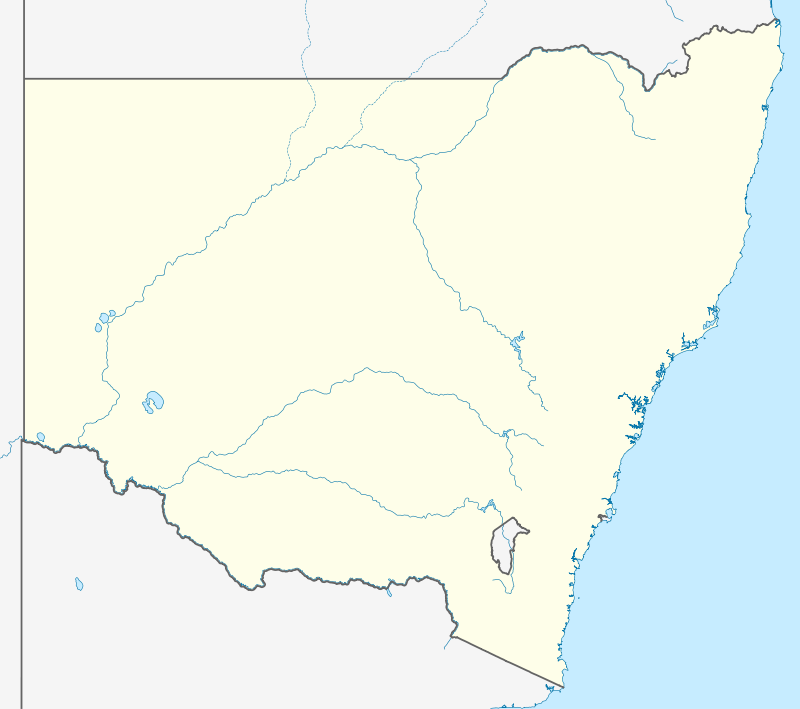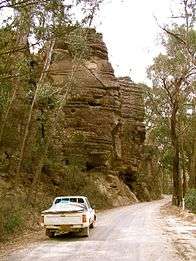Nerriga, New South Wales
Nerriga is a small village in the Southern Tablelands of New South Wales, Australia in Queanbeyan-Palerang Regional Council.[2][3] It is situated at the edge of Morton National Park, on the Braidwood - Nowra road. The population of Nerriga and the surrounding localities at the 2016 census was 72.[1]
| Nerriga New South Wales | |||||||||||||||
|---|---|---|---|---|---|---|---|---|---|---|---|---|---|---|---|
 Old butcher shop and house | |||||||||||||||
 Nerriga | |||||||||||||||
| Coordinates | 35°07′S 150°05′E | ||||||||||||||
| Population | 72 (2016 census)[1] | ||||||||||||||
| Postcode(s) | 2622 | ||||||||||||||
| Location | |||||||||||||||
| LGA(s) | Queanbeyan-Palerang Regional Council | ||||||||||||||
| Region | Southern Tablelands | ||||||||||||||
| County | St Vincent | ||||||||||||||
| Parish | Meangora | ||||||||||||||
| State electorate(s) | Monaro | ||||||||||||||
| Federal Division(s) | Eden-Monaro | ||||||||||||||
| |||||||||||||||
History



In 1828, grazier George Galbraith was listed as the owner of some 2,000 acres (810 ha) of land on the Endrick River, to the east of the current village. This property was then known as "Narriga".[4] The name "Nerriga" was first recorded by surveyor Robert Hoddle on an 1828 expedition of the Shoalhaven River.[5] Following Galbraith's death in 1837, his land holdings were subsequently auctioned.
In 1840, James Larmer surveyed a village site and a route over the mountains from Nerriga to Vincentia. It was intended that this pass, known as the Wool Road would allow movement of agricultural produce to a port on Jervis Bay from the Braidwood and Goulburn districts. The road was completed in 1841, a distance of approximately 37 miles (60 km) at an estimated cost of £997. In 1842, the existing road linking Nerriga to Braidwood was substantially upgraded. Both projects utilised convict labour under the command of Nerriga landowner Colonel John Mackenzie.[6]
The discovery of alluvial gold on the Shoalhaven River in 1851 led to increased interest in the area around Nerriga, and the town began to grow, with the Commercial Hotel opening for business some time around 1864.[7] The building still stands today, but is now known as the Bark Tree Hotel. Records show that between 1878–1901, the peak of production in the area, some 14,177 ounces (401,900 g) of gold were produced from the Nerriga Mining Division. Some quartz reefs were also worked in the area, however the yields from these activities were not significant. Prospecting on a large scale continued through to the 1960s.[8]
Nerriga had a state school from 1868 to 1917 and from 1928 to 1975. It was generally described as a "public school", but sometimes as "provisional" or "half-time."[9]
In October 2010, a substantial upgrade of the road between Nerriga and Nowra was completed by the Roads and Traffic Authority, New South Wales, the Commonwealth Department of Infrastructure and Transport and the Shoalhaven City Council, providing high quality, sealed all-weather road access for the community. A community celebration was held to mark the completion of the upgrade.[10]
References
- Australian Bureau of Statistics (27 June 2017). "Nerriga (state suburb)". 2016 Census QuickStats. Retrieved 29 June 2017.

- "Nerriga". Geographical Names Register (GNR) of NSW. Geographical Names Board of New South Wales. Retrieved 27 April 2018.

- "Nerriga". OpenStreetMap. Retrieved 27 April 2018.
- http://archiver.rootsweb.ancestry.com/th/read/AUS-CONVICTS/2002-03/1017223998
- "Nerriga". Geographical Names Register (GNR) of NSW. Geographical Names Board of New South Wales.

- http://www.stgeorgesbasin.info/level2/heritage.html
- http://nerriga.com.au/
- http://www.resources.nsw.gov.au/__data/assets/pdf_file/0011/109775/nerriga-gold-deposits.pdf
- "Nerriga in the School history database search". New South Wales Department of Education. Retrieved 3 May 2018.
- http://www.rta.nsw.gov.au/roadprojects/projects/south_eastern_region/mr92/